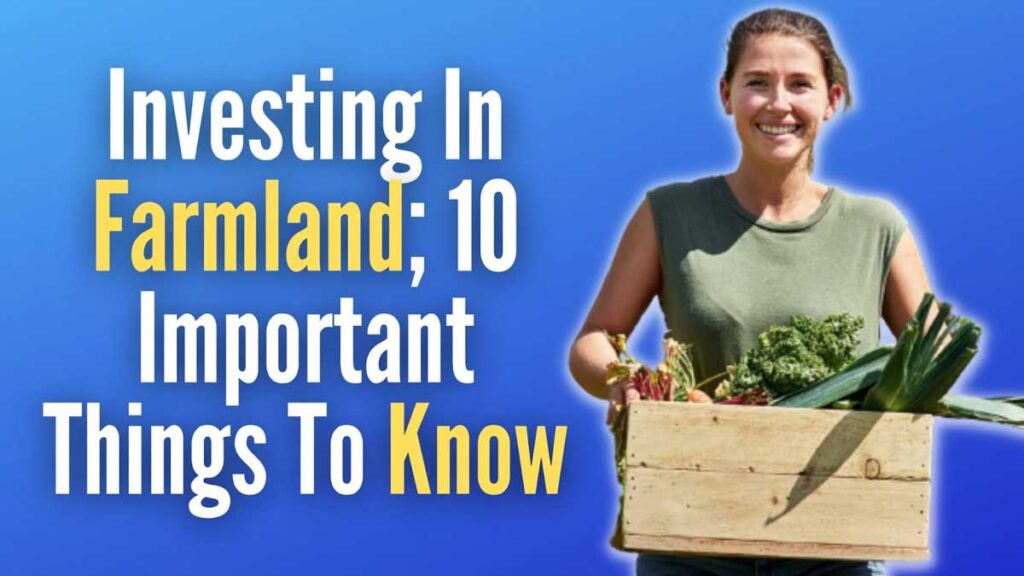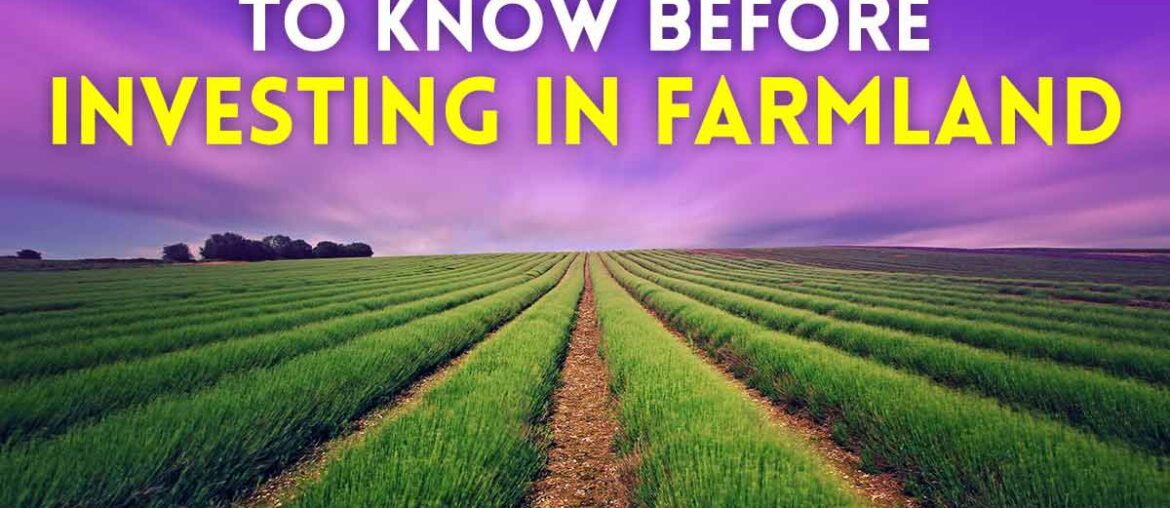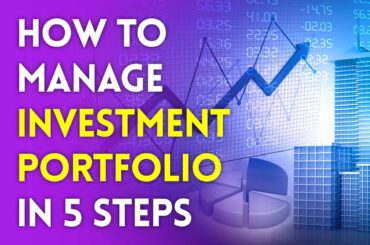
The United States Department of Agriculture estimates that there are over 2 million farms and almost 900 million acres of farmland in the country.
In the United States, about 60% of farmland was owner-operated as of the 2017 Census of Agriculture, meaning that the farmer who cultivates the land also owns the land.
The majority of rented land is owned by non-operator landlords like investment firms. Roughly 40% of farmland is rented, meaning the farmer does not own the property.
As a result, you have various options for investing in farms, but there are a few crucial things to understand first. We will discuss 10 important things to know before Investing in Farmland in this article.
10 Important Things To Know Before Investing In Farmland
1. There Are Several Ways To Make Money
Purchasing farmland could earn you money in a variety of ways. The two most fundamental ways are the prospective increase in land value and any rent paid to the farmer who cultivates the land.
Farmland ownership is a possibility for individuals who have the financial means to do so. You may purchase cropland or pastureland now, rent it out, and then sell it later, possibly generating a profit, because the value of farm real estate has historically improved with time.
For investors who also work their farmland, income from the sale of the crops they grow or from cattle that graze on the land could be generated.
2. Find Out Where The Water Sources Are
Knowing that you have plenty of water accessible for your crops and any prospective animals is important when working on a farm.
Where can You find water on or around your farm? Are there any water rules that you need to abide by?
Farmland without numerous water sources isn’t as helpful as it initially appears. Verify that there are no restrictions on how much water you can use and that you have enough for your needs.
Do you have wells? Lakes? Is there a river close by?
Contrary to what you may expect, crops use more water. Plan ahead.
3. Investments In Farmland Can Be Either Active Or Passive
Farmland can be an active or passive investment. An active investment could involve purchasing farmland and personally cultivating it to raise row crops or other agricultural items.
An investment in passive income is comparable to an investment in any other kind of real estate. Simply purchase the farmland, rent it out to generate passive income, retain it until the farmland value has improved, and then sell it for a profit.
You could alternatively choose a location in the center, work a portion of the property, and lease the remainder to a farmer, an investor in real estate, or someone else who wants to use the land for anything else.
IRS regulations define what counts as an active or passive investor and what counts as material engagement in a business, which is involved in a business on a regular, substantial basis. Your investment in farmland will be taxed by these regulations.
We advise you to speak with a tax expert with experience in this field to make sure you abide by any regulations that, in your case, distinguish between active, passive, and material participation.
If you wanna have passive income, Check out our guide on 31 Easiest Passive Income Ideas to Start with NO Money.
4. How Much Land Will You Need? Think About It
What you plan to do with this farmland is a matter only you know. Have you determined the precise amount of land you’ll need to accomplish your goal?
Be sure to perform the appropriate calculations before purchasing a farm. To figure out where everything has to go and how much space it would require, you can even create a hazy “floorplan.”
Even if it doesn’t do any harm to slightly overestimate this, you don’t want to go too far and end up paying for much more land than you actually require.
Farmland is expensive, and maintaining its aesthetic appeal is challenging. You’ll spend less time and money if you only buy what you need.
5. Its Volatility Is Historically Low
Compared to certain other investment types, farmland has generally had a low rate of volatility. The volatility of a price is the rate of change over time. More consistency and fewer price swings are indicators of low volatility.
For instance, the volatility of a farmland index from 1992 to 2020 was 6.9%. Farmland has been far more stable in its price than stocks over the same time period, with the S&P 500 index seeing a volatility of 17.15% and U.S. bonds experiencing a volatility of 4.55%, respectively.
6. It Might Serve As An Inflation Hedge.
In general, real estate is viewed as a hedge against inflation. To put it another way, it’s an investment with potential returns that might match or even outpace the rate of inflation.
Due to the fact that no new land is being created, real estate is a limited resource. Since it is limited, there is a greater chance that its value will rise over time.
As the world population continues to rise and, with it, the demand for food, this is true for farms, possibly more so than for other types of real estate.
The amount of farmland available decreases as urban and suburban areas spread farther apart, and new developments frequently take place on used agricultural land.
In fact, during several years between 1960 and 2012, farmland outperformed gold, a commodity that is frequently recommended as a reliable inflation hedge.
7. It Isn’t Very Good For Liquidity
No matter what kind, real estate is not a very liquid investment. You can convert an asset into cash if you have liquidity.
There is no daily liquidity in real estate investments, unlike investments in stocks, bonds, ETFs, or mutual funds. A real estate mutual fund or ETF investment is the exception to this rule. Publicly traded REITs might also offer this kind of liquidity in specific circumstances.
As with any other physical real estate investment, you must find a buyer for the property if you decide to invest in physical farmlands invest.
This could happen quickly, or it could take weeks, months, or longer, depending on the local market’s availability and demand for farmland.
There may be particular features of your property that, in addition to the general supply and demand for farmland, make it more or less valuable to a potential buyer.
When using a crowdfunding platform, a private equity farmland real estate fund, or another private investment vehicle, your investment may occasionally be illiquid because of time restrictions on when you can access it. Lock-up periods are the name given to these limitations.
Make sure to account for this lack of liquidity when investing in a farm, whether directly through land purchase, a private fund, or a pooled investment.
If you want to invest money, you must decide if you will need access to it or if you can tie up the funds in the hopes of getting a good return when you eventually sell the property or your investment in the fund.
8. Is Owning Farmland A Good Investment
It depends if buying farmland is a wise financial decision. In the case of farmland, an experienced investor who already has other investments and is seeking diversification is more likely to find it a good fit.
Publicly listed REITs like the aforementioned LAND and FPI, as well as others, are available for smaller investors or those who do not want to invest directly in farmland or a pooled farmland. These can be purchased and traded on the stock exchange every day, just like any other stock.
A crowdfunding website or a private equity fund investing in farms could be a smart addition to a portfolio as a diversifier for authorized investors who have liquidity elsewhere.
If a person has the money to invest in farmland directly and is willing to give up the liquidity of these assets, doing so could be a wise choice.
9. How To Invest In Farmland
How to invest in a farm? The term “farmland” describes agricultural land that is used exclusively for raising livestock or growing a range of crops.
Buying shares in agricultural land REITs, purchasing farmland directly, or purchasing shares of hedge funds with agricultural holdings are several ways that investors can invest in agricultural land.
Since agricultural lands are unaffected by changes in the price of securities in the financial markets, investors purchase them as a hedge against inflation.
Before you invest check out our guide on 12 Investing Strategies You Should Do Before Investing.
10. Expertise Might Be Needed
If you intend to purchase land directly, it is advisable to get the advice of professionals to estimate its value and your alternatives for developing the property.
You can lack practical knowledge of cattle, crops, or how to make an effective investment. To get the most out of your investment, it’s crucial to speak with knowledgeable experts.












